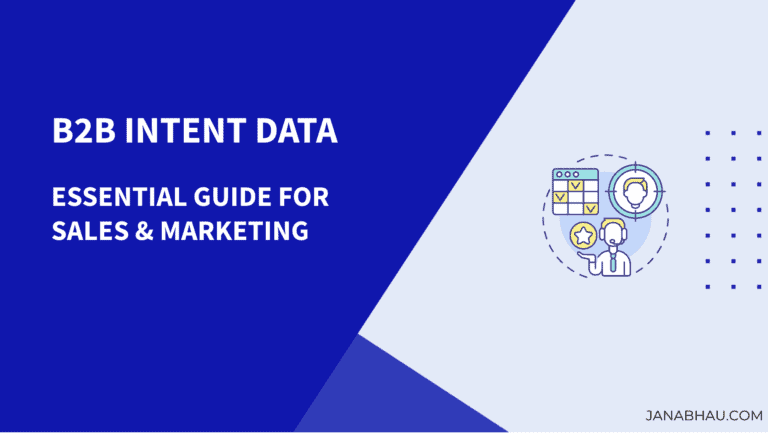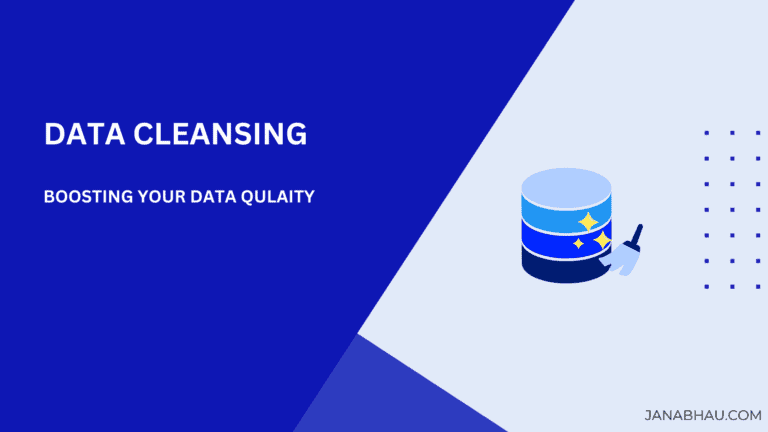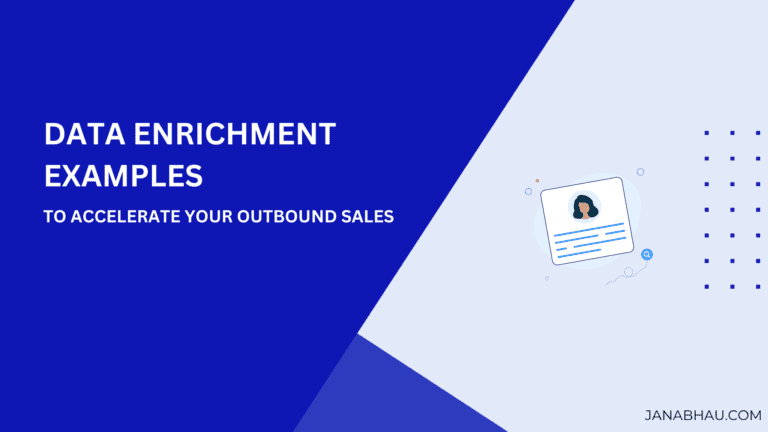A Comprehensive Guide to Buyer Enablement in 2024
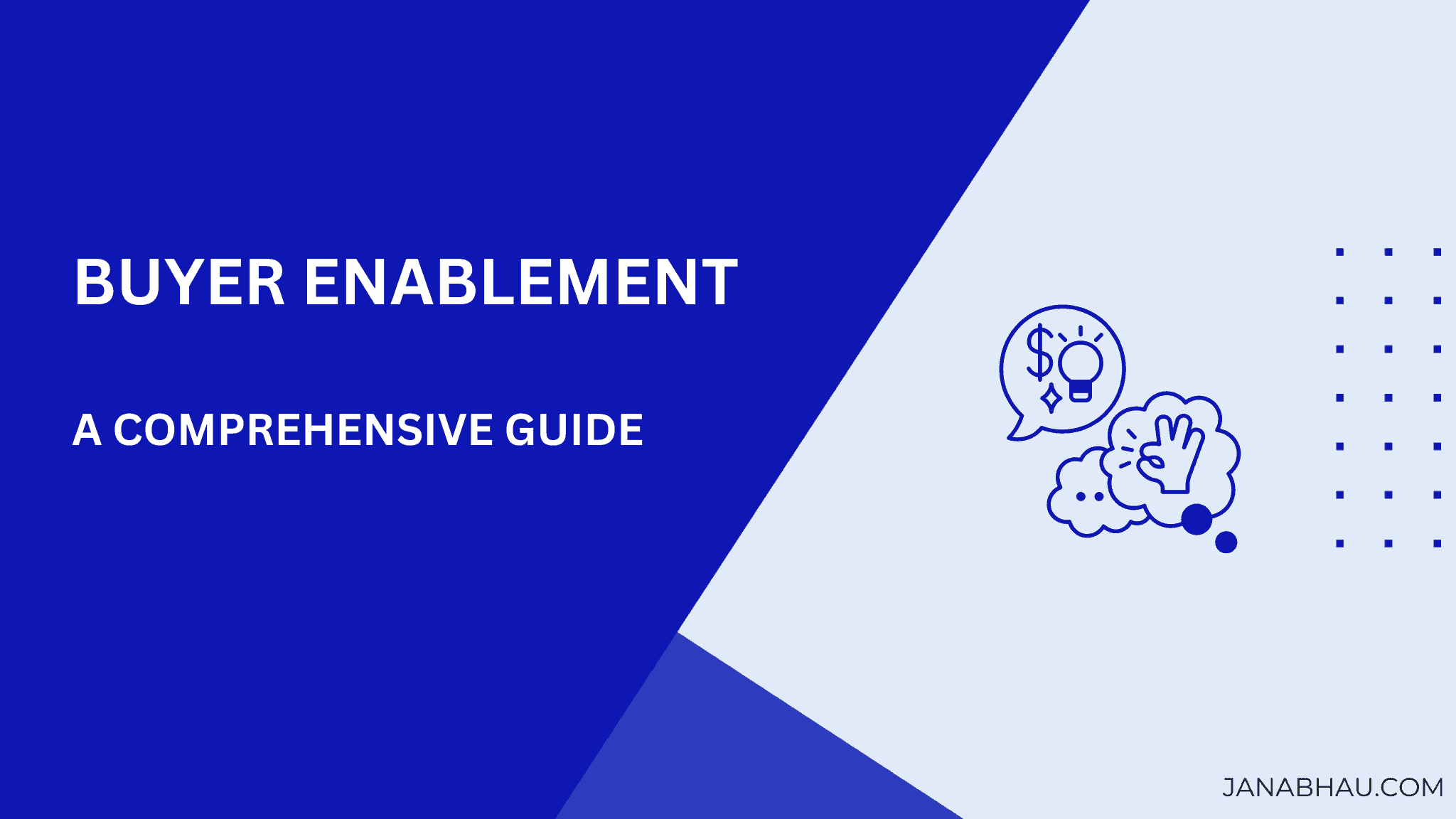
Imagine you’re shopping for a new laptop on Amazon. As you browse through various options, you notice that the website lists detailed product specifications, shares customer reviews, and even compares similar products.
With all theses resources in hand, you’re more likely to complete the purchase process. This seamless experience where information is readily available and tailored to your needs is what buyer enablement is all about.
In this article, we’ll explore what buyer enablement is and how it helps create a better buying experience.
Key Takeaways
- Buyer enablement is providing buyers with personalized tools, information, and support they need to make a purchase.
- Unlike sales enablement, buyer enablement focuses on the customer and improving their buying journey.
- Investing in the right buyer enablement strategy can boost sales outcomes and customer loyalty!
What is buyer enablement?

Buyer enablement is a customer-focused strategy to improve buying experiences. It helps customers make informed decisions by providing them all the information and tools that they need, right from initial awareness to post-purchase.
In a way, buyer enablement is supporting your customer throughout the purchase process, even after it is completed. Unlike sales or marketing initiatives, the focus is not on closing deals, instead it is to help your buyer make the right decision.
If you’re still wondering how buyer enablement actually helps your business (instead of your customer), you might’ve forgotten that customer is king!
Happier customers = Higher CLV (customer lifetime value) and recurring sales!
Implementing an effective buyer enablement strategy can help your sales reps by:
- Shortening the sales cycle by 20%
- Improving the revenue by 5-10% with the first year
- Achieving a win-rate close to 49%
To understand buyer enablement better, let’s look at how it improves the buyer’s journey for two kinds of businesses—one with a complex sales cycle and another with a self-serve purchase process.
Buyer enablement for businesses with a complex sales cycle
B2B businesses with complex sales cycles often deal with high-order values, multiple decision-makers, and organization-wide solutions. These challenges require a strategic approach to buyer enablement.
In such situations, you would need an internal champion to pitch your product or service to other stakeholders in the organization. Buyer enablement content such as comparison documents can help potential buyers understand the differences between your product and competitors, making it easier for them to justify the purchase internally.
Case studies showcasing successful implementations can provide real-world proof of your product’s value, while webinars offer an interactive platform to address specific questions and concerns.
Sales representatives operate as consultants rather than salesmen in the B2B sales process. But, this isn’t the case when it comes to self-serve products.
Buyer enablement for self-serve products or services
While a self-serve product or service has a shorter sales cycle, it also means that the sales reps have fewer touch points to convince buyers. Self-serve products battle high competition and fluctuating demand while trying to win customers.
These businesses need buyer enablement tools that buyers can explore on their own. For example,
- Video tutorials that provide step-by-step guidance on using the product or service
- Informative landing pages that address common questions and concerns
- Chatbots that offer real-time support, ensuring that potential buyers have the assistance they need at every stage of the buying process.
These strategies can empower customers and enable them to make decisions independently.
But wait, tools and resources that help sales conversions…aren’t those just sales enablement tools?
The confusion is obvious, because sometimes there’s an overlap between sales and buyer enablement tools. Yet, they both fulfill different functions.
Sales Enablement vs. Buyer Enablement
Sales enablement concentrates on preparing sales teams with the tools and information required for effective selling. In contrast, buyer enablement is about equipping buyers with resources necessary for informed decision-making.
To better understand the distinction between buyer enablement and sales enablement, let’s break it down into a simple comparison table:
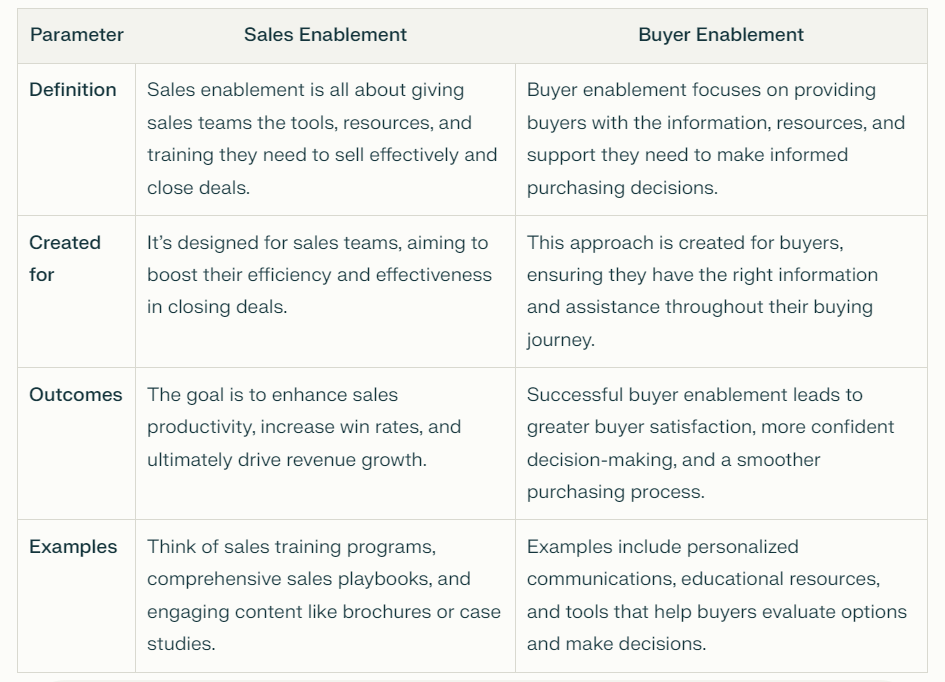
While some resources can be used for both sales enablement and buyer enablement, their application differs. For instance, a case study can serve as a powerful tool for sales reps to demonstrate the product’s value, but it can also help buyers understand how others have successfully used the product, aiding their purchase journey.
One isn’t better than the other, you need a buyer enablement strategy that fills the gaps that sales enablement can’t!
Benefits of investing in a buyer enablement strategy

Investing in a buyer enablement strategy isn’t merely a trend, but an essential tool to boost the buying cycle and close deals.
If you wish to enable buyers, you will need to invest some money and time into building a buyer enablement program for your product or service. This is a worthwhile investment since 84% of buyers prefer to complete a purchase with a sales representative who understands their goals.
Let’s look at how an effective buyer enablement strategy can transform your business:
- Increase sales outcomes including conversion rates, sales revenue, close deals, and sales effectiveness.
- Improve customer relationships throughout the buying process, for long-term satisfaction and loyalty.
- Convert potential buyers into happy customers with a long lifetime value.
- Address potential pain points early on and provide continuous support.
- Stand out from competitors by offering a personalized and supportive buying process.
In the next section, I’ll cover a step-by-step breakdown of the buyer enablement strategy and how you can formulate one for your business.
5 Steps to create a buyer enablement strategy
Buyer enablement is centered around empathy and a deep understanding of buyer behavior. There are many types of buying groups, and every product or service has its own USPs and challenges. So, your buyer enablement plan is likely just as unique as your business.
However, it all boils down to 5 simple steps:

1. Build a buyer persona
Building a buyer persona starts with defining your ideal customer. This includes demographic details like age, gender, income level, education, industry, location, team size, and structure.
A strong buyer persona should also highlight the customer’s needs and pain points, allowing you to align your objectives with their interests. Once you have a pool of buyers that fit your ideal customer profile (ICP), you can divide them into a few buying groups based on their willingness to buy. For example,
1. The amiable buyer
Amicable buyers are a friendly, encouraging kind who prefer a lower amount of risk in the buyer’s journey. Tools such as engaging workshops or marketing collateral like case studies can help such buyers.
2. The expressive buyer
The expressive buyers are the dreamers who have a vision for the product they purchase. In a B2B buying cycle, they might look at customizations or inspiring use cases. They generally thought leadership content pieces, ambitious case studies, or maybe a free trial to get more involved with the product.
3. The analytical buyer
This type of buyer won’t complete a purchase without a thorough analysis. They require high-value and well researched buyer enablement content during the sales journey including whitepapers, benchmark reports, and one-on-one demos.
4. The driver buyer
A driver buyer is the main decision maker, like a CEO or a manager, who makes the purchasing decisions. They may require executive summaries and goal oriented presentations to be fully convinced by your offerings.
Now, you can build personalized resources that would satisfy the requirements of these different buyer groups. Remember, your personas should evolve as you learn more about your customers over time.
2. Put yourself in the shoes of your customer
To gain a deep understanding of your customers, it’s crucial to empathize with their perspective. Begin by identifying frequent pain points and queries they might have prior to making a purchase. For instance, a buyer might be curious about the product’s return policy, its comparison to competitors, or its ability to solve their specific problem.
While devising a buyer enablement strategy, you can also take a look at the most frequently asked questions or doubts received during sales demos. Any sales notes, call recordings, or requisites shared in a sales form are all great indicators of what your customers are looking for.
Do they want to understand the ROI from your product or service? Share a compelling case study that highlights the benefits and successes experienced by previous customers.
Do they want to explore the product before implementing it? Offer a free trial so they can explore its features and value firsthand.
You get the gist!
3. Collect post-sales feedback from your customers
You can’t fix a problem unless you know what went wrong! The good and bad news is that your customers never forget their negative experiences. The good news is that they’ll be willing to share that information with you, if you ask for it.
Gathering post-sales feedback is vital for assessing the effectiveness of your buyer enablement strategy and pinpointing areas for enhancement. One efficient method to collect feedback is through surveys, which can be dispatched immediately post-purchase to capture customers’ immediate and emotional responses. Open-ended questions within these surveys can yield detailed insights into the customers’ experiences and sentiments.

Using CRMs, like Salesforce, to manage and analyze this feedback can streamline the process and ensure that all responses are considered.
4. Identify high-drop off sales stages
High-drop off sales stages can be a significant barrier to closing deals. To identify these stages, analyze customer journey data to spot where deals are most likely to stall. These stages are the biggest chokers in your sales pipeline!
Common reasons for drop-offs include long sales cycles, complex decision-making processes, and a preference for the status quo.
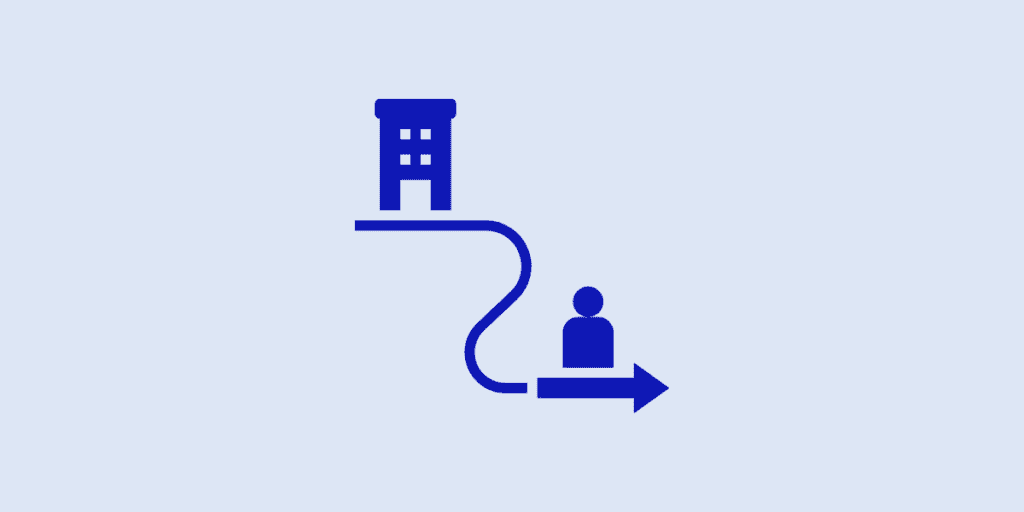
Addressing these stages requires a strategic approach. Here are some tips to help you navigate these challenging points in the sales process:
- Design additional buyer enablement content to specifically help buyers make an informed decision.
- Simplify purchasing decisions by offering clear and concise information.
- Offer targeted support to address any concerns or objections.
By following these tips, you can reduce drop-offs and improve overall conversion rates.
5. Create high-impact resources
Creating high-impact resources is essential for effective buyer enablement. You can ensure that your content is high-impact by including relevant data points, value-based information, and interactive elements.
These resources should address the specific pain points and challenges faced by your buyers. For example, case studies that showcase real-life success stories can be very influential in the decision-making process. Interactive content like calculators, quizzes, and assessments can also engage and educate potential buyers.
Webinars and live demos provide an opportunity to offer in-depth information and answer real-time questions from buyers, making them excellent tools for buyer enablement. Sales reps should focus on personalizing the content throughout the buyer’s journey to engage modern buyers effectively.
While reading through this strategy, you would have realized that you can’t close deals faster unless you have some buyer enablement content in place. Let’s figure out which resource to invest in, based on the biggest blockers in your sales process.
Which buyer enablement content to invest in?
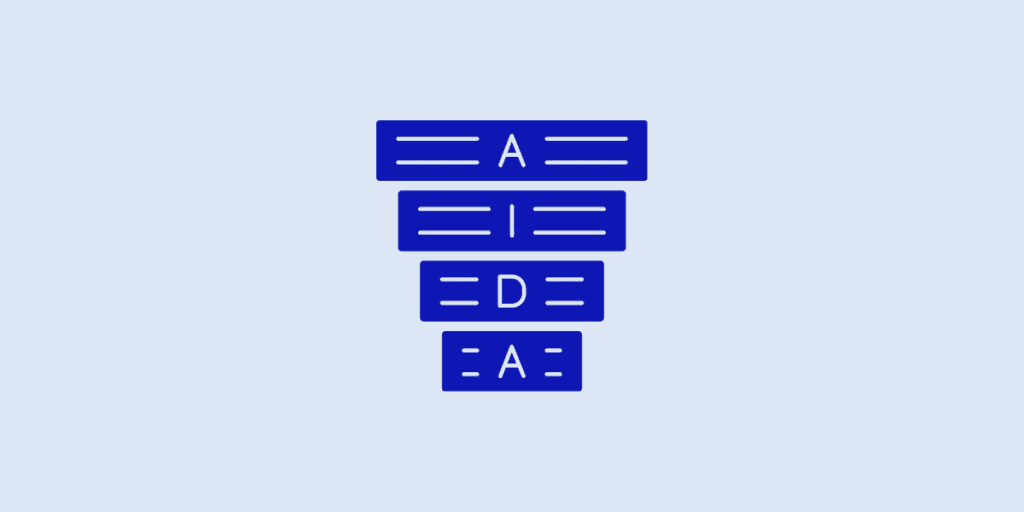
To optimize your buyer enablement strategy, investing in the appropriate resources at each stage of the buying process, is crucial: Awareness, Interest, Desire, and Action.
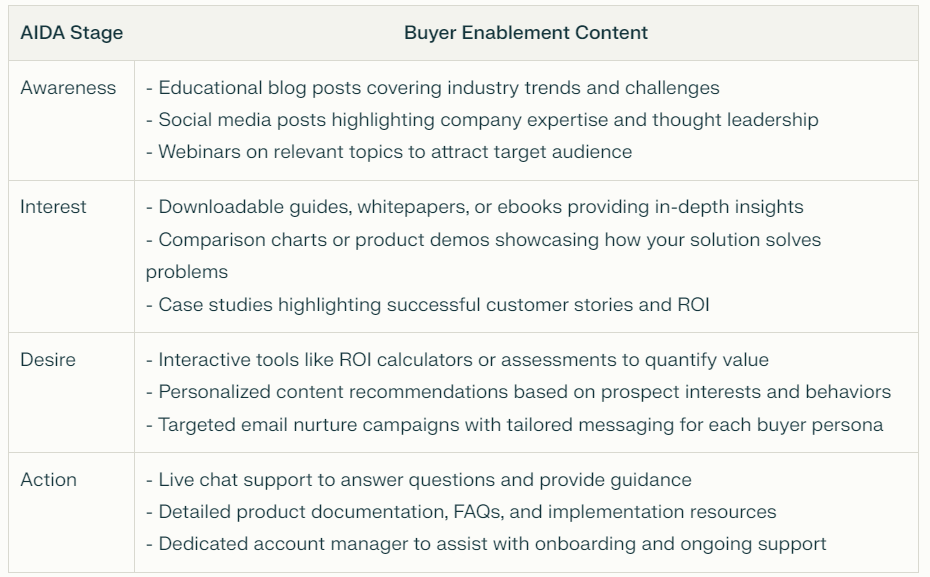
Awareness
In the Awareness stage of the buying process, buyers are just beginning to recognize a need or problem. Here, TOFU (Top of the funnel) resources like video tutorials, infographics, and blogs can help educate buyers and spark their interest.
For instance, HubSpot uses educational blogs and checklists to attract and inform potential customers right from the start of their buying journey.
Interest
During the Interest stage, buyers are actively seeking more information about possible solutions. eBooks, detailed guides, and webinars are a few examples of resources for helping buyers with in-depth knowledge while showcasing your expertise.
For example, Salesforce leverages comprehensive case studies to highlight successful CRM software implementations, demonstrating measurable ROI and business impact.
Desire
The Desire stage is where buyers start to narrow down their options and almost have all the resources to make an informed decision. Case studies, product demos, and ROI calculators can help them see the tangible benefits of choosing your product.
Microsoft excels in this stage by offering detailed case studies and interactive demos that highlight the success of their products.
Action
Finally, in the Action stage, buyers have reached the end of the buying process and are ready to make a purchase. Sales professionals can offer free trials, personalized consultations, and enable clear call-to-action (CTA) buttons in their content to conclude purchasing decisions.
For example, Shopify’s free trial and personalized onboarding sessions are great examples of how to convert interested leads into satisfied customers.
With a strategy for buyer enablement and the best resources in place, you’re in the right place to start helping buyers. Now, all that’s left is the secret sauce, the best practices that the leaders have implemented in their buying process.
Best practices to take your buyer enablement to the next level in 2024
Enhancing your buyer enablement strategy necessitates the adoption of best practices that align with modern buyers’ preferences. These best practices focus on empowering buyers and streamlining the sales approach.
1. Offer Incentives and Rewards
Offering incentives and rewards is a powerful way to boost buyer enablement and loyalty. It is a true testimony of your commitment towards customer experience!
A well-designed loyalty program can offer valuable rewards such as discounts, free products, or exclusive event access. For example, Starbucks’ Rewards program offers free drinks and personalized offers, encouraging repeat purchases and brand loyalty.
Incentives can also take the form of gamification, where customers earn points for specific actions like purchases, use of certain features, reviews, or testimonials. This approach not only increases engagement but also makes the buying process more enjoyable.
2. Personalize your buyer enablement
Personalizing buyer enablement is essential in today’s competitive market. Ecommerce stores, for instance, can offer:
- Customized product recommendations based on browsing and purchase history
- Personalized email marketing campaigns
- Tailored discounts and promotions
- Individualized customer support
This not only helps customers find products that align with their needs but also improves retention over time by ensuring everyone is on the same page.
You can utilize a CRM software or a marketing automation tool to gauge your buyers preferences right from the start. Further communication, or sharing of marketing collateral, can be personalized and automated using the tool’s segmentation features.
3. Measure and analyze results
To ensure the success of your buyer enablement strategy, it’s crucial to measure and analyze results. Key metrics like:
1. Customer Satisfaction (CSAT),
2. Net Promoter Score (NPS),
3. and Customer Effort Score (CES),
provide valuable insights into customer satisfaction and loyalty. These metrics can be collected through post-interaction surveys and analyzed to identify areas for improvement.
Product usage metrics and conversion rates from engagement efforts can also help you understand how customers interact with your product and whether your strategies lead to sign-ups or purchases. Regularly reviewing these metrics ensures that your buyer enablement strategy remains effective and aligned with your business goals.
4. Utilize user generated content
User-generated content (UGC) is a valuable resource for enhancing buyer enablement. The sales team can encourage customers to share positive case studies, testimonial videos, or reviews on popular software review websites and all of these resources can be utilized as user generated content.
Encouraging customers to share their experiences and post content related to your brand fosters a sense of community and loyalty. Highlighting this content on your online channels, such as social media, can increase engagement and create a more authentic connection with potential buyers.
Leveraging UGC is a great option because it helps you save on creation costs, while building trust and credibility among your audience.
5. Invest in a buyer enablement tool
Investing in a buyer enablement tool can streamline and enhance your engagement efforts. Customer Relationship Management (CRM) solutions help manage customer interactions, data, and relationships efficiently. A Customer Engagement Platform (CEP), designed to optimize interactions across various touchpoints, can significantly improve customer satisfaction and drive sales.
Both, CRMs and CEPs help you improve buyer journey, but CEP might be a better fit. The tool is easy to use but you can still arrange a sales training to ensure that your sales reps are on the same page.
Top CEPs for 2024 like Voiceflow, Zendesk, and Salesforce Service Cloud offer features such as AI-driven personalization and real-time analytics.
Wrapping up and my experience
In conclusion, prioritizing buyer enablement and implementing best practices can completely transform the buyer experience and result in improved sales outcomes.
Drawing from my experience as a sales enablement manager, I’ve learned that prioritizing the improvement of the buying process, rather than just focusing on the sales process, isn’t the default approach. However, it is absolutely necessary.
Most modern buyers, particularly in the B2B sector, prefer to conduct their own research first. They delay engaging with sales until much later in the decision-making process. This makes a buyer-centric strategy essential. By analyzing what information can be provided early on, you can make the buying process smoother for decision-makers and champions. This can be the key reason prospects choose to partner with you.
Concentrating on the customer experience has not only boosted our sales but also helped us retain customers, turning them into advocates among their peers. The key is to maintain the mindset of a buyer advisor rather than a traditional seller.
Frequently Asked Questions
What is buyer enablement?
Buyer enablement provides buyers with the knowledge, information, and tools needed to make informed purchase decisions, including pre-purchase and post-purchase activities. Your sales reps can offer these resources to the buying team to simplify the buying journey.
How does buyer enablement differ from sales enablement?
Buyer enablement differs from sales enablement in that it focuses on providing resources to buyers to make informed decisions, rather than equipping sales teams to sell better.
Why is it important to invest in a buyer enablement strategy?
It’s important to invest in a buyer enablement strategy because it improves sales outcomes, nurtures customer relationships, and increases brand recall, ultimately leading to higher conversion rates and customer loyalty.
What are some best practices for improving buyer enablement in 2024?
To improve buyer enablement, consider:
1. Offering incentives
2. Personalizing engagement
3. Analyzing results
4. Using user-generated content
5. Investing in a buyer enablement tool.
These practices can help drive better results and enhance the overall buyer experience.
What types of resources should businesses invest in for buyer enablement?
To effectively engage and educate buyers, businesses should invest in resources like:
1. Video tutorials
2. eBooks
3. Webinars
4. Case studies
5. Personalized consultations
6. Whitepapers
7. ROI Calculators
These resources can help buyers or a buying team by and providing them with valuable information.

